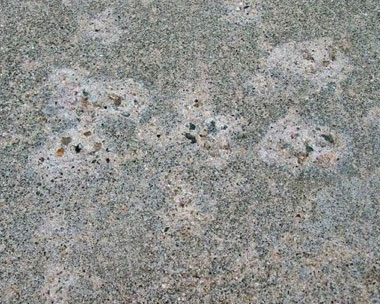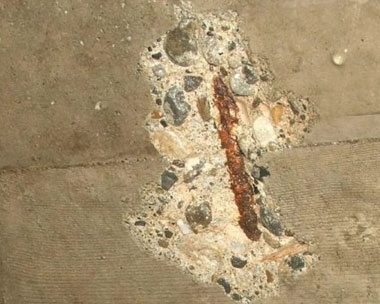By Rob English
When spring arrives, the snow fighter faces a large workload of preparing the winter maintenance equipment for a long summer’s nap, cleaning up any winter kill, and, responding to a series of questions and complaints from the property owners on the efforts put forth over the winter months. Inevitably, the topic of concrete damage will come up. Concrete damage from winter snow operations generally comes in two forms; impact/scrape damage from mechanical contact such as loader buckets and snow pusher edges colliding with curbing or scraping the surface, and, spalling damage.
Spalling damage is common in concrete and most of the time it is caused by substandard concrete. While the concrete in the truck that is poured in place is usually within specification, the art of properly installing, floating, and burping the air from the concrete varies widely amongst installers. When we see spalling damage, most often it presents as a loss of the top surface area down to the aggregate as shown in the photo below. Sometimes it looks like someone took a shotgun to the sidewalk and lots of small “blast craters” appear, and sometimes it is widespread and wholesale failure of the surface.

To understand how spalling damage happens, first know that it is generally NOT a chemical attack. In some rare cases such as high dolomite concrete mixes, there is evidence to suggest that those concrete mixes may be susceptible to magnesium compounds of all types whether they are fertilizers or ice melter. But that is the exception by far and not the rule and it appears to be limited only to a small area of Iowa based on just one report. Far more common is freeze:thaw related spalling damage whereby brines formed by melted snow enter the air pockets of the concrete and refreeze when temperatures drop below the freezing point of the brine overnight. When water or brines freeze, just like the ice cubes in your refrigerator’s freezer tray, they expand. If they are trapped inside an air pocket void and expand when they freeze, then those brines will displace the concrete shell holding them back.

I was called in to analyze a complaint on spalling damage to a concrete floor that was claimed to be from deicers a number of years ago in the Baltimore, MD area. I went to look at the site and the damage that was evident was typical spalling damage, but what was curious about it was that the spalling failure was very deep and crater like; almost like a little volcano. The investigation was involved and included a number of parties and when we finally found the root cause, it was pretty stunning: The concrete company that made the concrete had a bulk pneumatic trailer that they used to pick up bulk concrete. They had made a deal with a local limestone company to haul bulk quicklime to a site near where they picked up concrete and the same truck would haul quicklime up and concrete back without any washout. The concrete was contaminated with small bits of quicklime which attacked the concrete chemically and caused deep pock spalling. That is a rare incidence of chemical derived spalling but as snow-fighters it is also important to remember that while our DNA might be at the crime scene, we are not always the one who caused the problem.
Some of the things that the snow removal contractor should do is to become alert to recognizing places that may be susceptible to spalling before the winter even begins and point them out to the property owner in advance. Areas of new concrete, and many of the newer high end colored stamped concrete surfaces all can be more susceptible to damage than well established concrete.

In addition to areas of new concrete, be vigilant to recognize subtle signs of failure underway which may be exacerbated by the snow-fighter’s work with deicers such as what you see in the photo below:

On first glance, these steps might appear to be solid, and they should be since they are well over 20 years old. However if you look closely you can see streaks of rust. Concrete doesn’t normally show rust unless the reinforcing bar and concrete matrix are failing; and that is exactly what is happening with these steps.

Right now they are stable, but if you look closely at them you will see a significant crack running the length of the steps that has opened the concrete below to accept all the melted brine from winter maintenance and it is just waiting to fill up with fluid, refreeze, and blow the front corner of these steps off. As the snow removal contractor is charged with keeping these clear, he will also be blamed for the failure that is immanent.

Spalling damage comes in a few forms; as small pock marks that look like someone took a shotgun to the concrete surface, and sometimes as widespread wholesale destruction of as section of the entire surface. Your concrete installer doesn’t want to hear that it’s his problem, which in my professional opinion it actually is most of the time. He doesn’t want the liability of replacement saddled upon him, so normally the source of concrete damage becomes the commercial equivalent of the children’s game “hot potato” where the buck is passed quickly in an attempt to dodge responsibility for the problem. The image below shows spalling failure in a structural concrete matrix with re-bar first taking on brines to start the rot and then freeze-thaw damage causes whole chunks to fall. This is how bridges are adversely affected by chloride based and corrosive deicers.

The key to managing complaints about concrete damage is to avoid becoming entrapped by it. Survey the property carefully and look for areas of new concrete, or places where concrete is obviously susceptible to damage; areas that have new concrete, replaced and/or repaired areas are all going to be more likely to suffer from the freeze-thaw spalling damage until the concrete is at least two years old. After that, it’s a matter of the quality of the concrete and installation that will play a significant role in whether or not it shows damage. Applying a sealer to new concrete helps a great deal.
The world of concrete sealers has improved a great deal in the past decade or two and often, commercial concrete sealers will ward off any opportunity for spalling damage in concrete provided they are applied in accordance with the manufacturer instructions.
In summary, concrete spalling damage most of the time is a mechanical attack that is totally preventable. In my experience communication is the key to effectively side-stepping blame for concrete damage when deicers are suspected. Remember that when brines or water freeze, they expand and that is what causes most spalling damage.
Most importantly, understand that some deicers are less likely to inflict hard freeze-thaw cycles than others as it relates to this type of problem. The Federal Highway Administration conducted testing on salt, calcium chloride and magnesium chloride for freeze thaw damage following multiple cycles. The results are available on our website or by searching the internet for SHRP Report C-391
CMA is calcium magnesium acetate and it is the product of choice and most often recommended for new concrete, structural concrete as found in elevated walkways and parking garages, and in places with salt prohibitions. It is 100% calcium magnesium acetate and it is safe for new concrete and it does work. However, a small portion of CMA mixed with salt provides no corrosion benefit whatsoever, and tests have proven that benefits from CMA do not begin until it is at least 20% of the blend, and really the number is closer to at least 40% for meaningful benefit. The PNS and Clear Roads corrosion study is about to be released and it confirms that CMA is a good product. Adding a pinch of CMA to a bag of salt however, is no more effective at corrosion than adding a pinch of gasoline to a tank full of water is at running your car. Remember to demand a certified analysis of any deicer that you are buying or using on new concrete because we get calls every day from people that have unwittingly purchased a blend of salt with a pinch of CMA thinking that it is safe for their new concrete only to find out too late that they were duped by deceptive labeling. Watch for a future article on this topic that will contain some startling details about the fraud of CMA in packaged deicers.
You can always use straight abrasives such as sand on any new concrete and minimize the likelihood of spalling no matter what the quality. If deicers must be used, then it is important that the owner of the new or susceptible concrete understands the risks associated with freeze point depression deicers and freeze-thaw cycles.